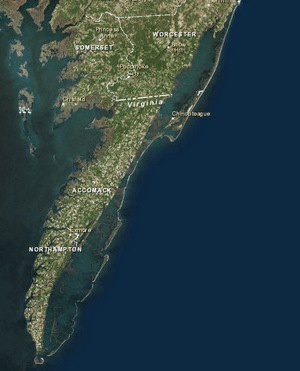Virginia Barrier Islands facts for kids
The Virginia Barrier Islands are a long chain of sandy islands along the coast of Virginia. They are like natural walls that protect the mainland from ocean waves and storms. These islands are separated by narrow water channels called inlets. Between the islands and the mainland are shallow, marshy areas called tidal bays. Most of these islands are not lived on by people. This makes them very important places for nature and wildlife. Several of them are part of a special protected area called the Virginia Coast Reserve.

Contents
Exploring Virginia's Barrier Islands
The Virginia Barrier Islands stretch from the border of Maryland and Delaware all the way south to the mouth of the Chesapeake Bay. They are a unique natural feature.
What Are Barrier Islands?
Imagine a long, narrow strip of sand that sits offshore, parallel to the mainland. That's a barrier island! These islands are formed by sand moved by ocean currents and waves. They act as a natural shield, protecting the coast from the strong forces of the ocean, like big waves and storm surges. This protection helps keep the mainland safe and creates calm, shallow waters behind the islands, which are perfect for marshes and wildlife.
A Look at Each Island
The Virginia Barrier Islands are a series of distinct islands. Here they are, listed from north to south:
- Assateague Island
- This is the first true barrier island you'll find when coming from the north. It's also the longest.
- Assateague Island is special because it's split between Maryland and Virginia.
- It's famous for its wild horses, known as the Chincoteague Pony. These ponies roam freely on the island.
- Chincoteague Island
- This island used to be a barrier island itself.
- However, over time, Assateague Island moved south and now protects Chincoteague from the direct ocean waves.
- Wallops Island
- This island is home to a very important place: Wallops Flight Facility.
- It's a base used by NASA for launching rockets and scientific research.
- Assawoman Island
- This island is part of the Chincoteague National Wildlife Refuge. This refuge is a protected area for many different kinds of animals and plants.
- Metompkin Island
- This island is shared between two important groups: the Nature Conservancy and the Chincoteague National Wildlife Refuge. Both work to protect its natural environment.
- Cedar Island
- A building that used to be a US Coast Guard station is still on this island.
- It's now owned by private individuals who sometimes stay there.
- The last private house on the island fell into the sea in 2014 due to erosion.
- Parramore Island
- This island is owned by the Nature Conservancy, a group dedicated to protecting important natural lands and waters.
- Hog Island
- This island was once home to a town called Broadwater, Virginia.
- The town had to be evacuated in 1936 after a powerful hurricane.
- It's also the origin of a special kind of sheep called the Hog Island sheep.
- Cobb Island
- This island also used to have people living on it.
- It even had a resort hotel, a church, and a small town.
- However, a big hurricane in 1896 caused a lot of damage, and the town was abandoned.
- Wreck Island
- This island is a natural area preserve, meaning it's protected for its natural features and wildlife.
- Shipshoal Island
- Another one of the many barrier islands in this chain.
- Myrtle Island
- Part of the continuous chain of these important islands.
- Smith Island
- This island has a rich history. It was once owned by the Custis family of Virginia.
- Martha Custis Washington, the wife of George Washington, owned this island.
- It is home to the Cape Charles Lighthouse, which is the tallest lighthouse in Virginia and the second tallest in the United States.
- Smith Island is now owned by the Nature Conservancy, protecting its natural beauty.
- Fisherman Island
- This is the southernmost of the Virginia barrier islands.
- It's located right at the entrance to the Chesapeake Bay.
- The island's shape changes a lot because of waves and water runoff. It first formed about 200 to 250 years ago.
- Fisherman Island is part of the United States Fish and Wildlife Service's Eastern Shore of Virginia National Wildlife Refuge.
- A major road, U.S. Highway 13, and the Chesapeake Bay Bridge–Tunnel pass right through the island.
- This island is a vital habitat for many birds, including migratory waterfowl, shorebirds, and nesting waterbirds.
Why These Islands Are Important
Because most of the Virginia Barrier Islands are not inhabited by people, they provide a safe haven for many different kinds of wildlife. They are crucial nesting grounds for birds, and their marshes are nurseries for fish and crabs. They also continue to protect the mainland from the ocean's power, even as they naturally shift and change over time.

